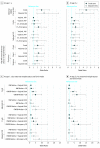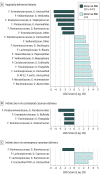Roles of Birth Mode and Infant Gut Microbiota in Intergenerational Transmission of Overweight and Obesity From Mother to Offspring
- PMID: 29459942
- PMCID: PMC5875322
- DOI: 10.1001/jamapediatrics.2017.5535
Roles of Birth Mode and Infant Gut Microbiota in Intergenerational Transmission of Overweight and Obesity From Mother to Offspring
Abstract
Importance: Maternal overweight, which often results in cesarean delivery, is a strong risk factor for child overweight. Little is known about the joint contribution of birth mode and microbiota in the infant gut to the association between maternal prepregnancy overweight and child overweight.
Objective: To investigate the association of birth mode with microbiota in the infant gut, and whether this mediates the association between maternal and child overweight.
Design, setting, and participants: An observational study was conducted of 935 full-term infants born between January 1, 2009, and December 31, 2012, in the Canadian Healthy Infant Longitudinal Development (CHILD) birth cohort. Maternal prepregnancy body mass index (BMI) was calculated as weight in kilograms divided by height in meters squared using height and weight data taken from medical records or maternal report. Infant gut microbiota were profiled with 16S ribosomal RNA sequencing in fecal samples collected at a mean (SD) age of 3.7 (1.0) months. At ages 1 and 3 years, BMI z scores adjusted for age and sex were generated according to World Health Organization criteria. Statistical analysis was conducted from January 29 to June 15, 2017.
Exposures: Mothers of normal weight (BMI, 18.5-24.9) and overweight or obese (BMI, ≥25.0) mothers.
Main outcome and measures: Risk of overweight and obesity (>97th percentile BMI z scores) among children at ages 1 and 3 years.
Results: Of the 935 mother-infant pairs in the study (mean [SD] age, 32.5 [4.5] years) 382 (40.9%) were overweight, 69 of 926 infants (7.5%) were overweight at age 1 year, and 90 of 866 infants (10.4%) were overweight at age 3 years. Compared with being born vaginally to a mother of normal weight, infants born vaginally to overweight or obese mothers were 3 times more likely to become overweight at age 1 year (adjusted odds ratio [OR], 3.33; 95% CI, 1.49-7.41), while cesarean-delivered infants of overweight mothers had a 5-fold risk of overweight at age 1 year (adjusted OR, 5.02; 95% CI, 2.04-12.38). Similar risks were also observed at age 3 years. Multiple mediator path modeling revealed that birth mode and infant gut microbiota (Firmicutes species richness, especially of the Lachnospiraceae family) sequentially mediated the association between maternal prepregnancy overweight and childhood overweight at ages 1 and 3 years. Bacterial genera belonging to the Lachnospiraceae family were more abundant in infants of overweight mothers; however, the participating genera of Lachnospiraceae differed between infants delivered vaginally and those delivered via cesarean birth.
Conclusions and relevance: This study found evidence of a novel sequential mediator pathway involving birth mode and Firmicutes species richness (especially higher abundance of Lachnospiraceae) for the intergenerational transmission of overweight.
Conflict of interest statement
Figures




Comment in
-
Maternal Microbiota, Prepregnancy Weight, and Mode of Delivery: Intergenerational Transmission of Risk for Childhood Overweight and Obesity.JAMA Pediatr. 2018 Apr 1;172(4):320-322. doi: 10.1001/jamapediatrics.2017.5686. JAMA Pediatr. 2018. PMID: 29459936 No abstract available.
Similar articles
-
Does vaginal delivery mitigate or strengthen the intergenerational association of overweight and obesity? Findings from the Boston Birth Cohort.Int J Obes (Lond). 2017 Apr;41(4):497-501. doi: 10.1038/ijo.2016.219. Epub 2016 Nov 30. Int J Obes (Lond). 2017. PMID: 27899809 Free PMC article.
-
Does birth mode modify associations of maternal pre-pregnancy BMI and gestational weight gain with the infant gut microbiome?Int J Obes (Lond). 2020 Jan;44(1):23-32. doi: 10.1038/s41366-018-0273-0. Epub 2019 Feb 14. Int J Obes (Lond). 2020. PMID: 30765892 Free PMC article.
-
Pre-labor and post-labor cesarean delivery and early childhood adiposity in the Canadian Healthy Infant Longitudinal Development (CHILD) Cohort Study.Int J Obes (Lond). 2024 May;48(5):717-724. doi: 10.1038/s41366-024-01480-z. Epub 2024 Feb 1. Int J Obes (Lond). 2024. PMID: 38302592
-
Impact of maternal smoking on the infant gut microbiota and its association with child overweight: a scoping review.World J Pediatr. 2019 Aug;15(4):341-349. doi: 10.1007/s12519-019-00278-8. Epub 2019 Jul 9. World J Pediatr. 2019. PMID: 31290060 Review.
-
Offspring body size and metabolic profile - effects of lifestyle intervention in obese pregnant women.Dan Med J. 2014 Jul;61(7):B4893. Dan Med J. 2014. PMID: 25123127 Review.
Cited by
-
Association of Gut Microbiota Composition with Stunting Incidence in Children under Five in Jakarta Slums.Nutrients. 2024 Oct 11;16(20):3444. doi: 10.3390/nu16203444. Nutrients. 2024. PMID: 39458441 Free PMC article.
-
The importance of gut microbiome in the perinatal period.Eur J Pediatr. 2024 Dec;183(12):5085-5101. doi: 10.1007/s00431-024-05795-x. Epub 2024 Oct 3. Eur J Pediatr. 2024. PMID: 39358615 Review.
-
Predicting newborn birth outcomes with prenatal maternal health features and correlates in the United States: a machine learning approach using archival data.BMC Pregnancy Childbirth. 2024 Sep 17;24(1):603. doi: 10.1186/s12884-024-06812-5. BMC Pregnancy Childbirth. 2024. PMID: 39289636 Free PMC article.
-
Long-Term Exposure to Polystyrene Microspheres and High-Fat Diet-Induced Obesity in Mice: Evaluating a Role for Microbiota Dysbiosis.Environ Health Perspect. 2024 Sep;132(9):97002. doi: 10.1289/EHP13913. Epub 2024 Sep 3. Environ Health Perspect. 2024. PMID: 39226184 Free PMC article.
-
The Impact of Gestational Diabetes Mellitus (GDM) on the Development and Composition of the Neonatal Gut Microbiota: A Systematic Review.Microorganisms. 2024 Jul 31;12(8):1564. doi: 10.3390/microorganisms12081564. Microorganisms. 2024. PMID: 39203408 Free PMC article. Review.
References
-
- de Onis M, Blössner M, Borghi E. Global prevalence and trends of overweight and obesity among preschool children. Am J Clin Nutr. 2010;92(5):1257-1264. - PubMed
-
- Flegal KM, Carroll MD, Kit BK, Ogden CL. Prevalence of obesity and trends in the distribution of body mass index among US adults, 1999-2010. JAMA. 2012;307(5):491-497. - PubMed
Publication types
MeSH terms
Grants and funding
LinkOut - more resources
Full Text Sources
Other Literature Sources
Medical

